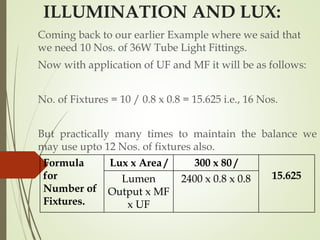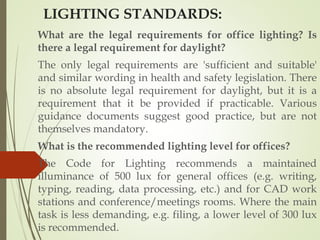electrical lighting calculation
- 1. BUILDING SERVICES - II: ELECTRICAL SERVICES: Unit – V: Lighting Calculation: NBC standards, nominal illumination levels in building interiors, lux, lumen, intensity, lighting schemes. Submitted to Submitted by Kiran sir . M.v.kamesh, 14061aa006.
- 2. ILLUMINATION AND LUX: What is the method for calculating illumination ? The problem of the Architect / Lighting Designer at the functional level is to determine how many lights and where to place them to get the correct level of illumination for a given activity. What do we understand by LUX ? The lux (symbol: lx) is the SI unit of illuminance and luminous emittance, measuring luminous flux per unit area. It is used in photometry as a measure of the intensity, as perceived by the human eye, of light that hits or passes through a surface. It is analogous to the radiometric unit watts per square metre, but with the power at each wavelength weighted according to the luminosity function, a standardized model of human visual brightness perception. In English, "lux" is used in both singular and plural.
- 3. ILLUMINATION AND LUX: One lux is equal to one lumen per square metre:
- 4. ILLUMINATION AND LUX: One lux is equal to one lumen per square metre: In other words .. LUX = Level of Illumination. OR LUX (lx) = Lumens / Sq.M. Level of Illumination ? LUMEN METHOD: This method works perfectly in most cases where the height of the ceiling is within 3000 mm from floor level, the Working Plane is between 750 to 1000 mm and
- 5. ILLUMINATION AND LUX: How To Calculate Lux ? How do I calculate lux - the formula? Lux level = total light output (lumens) / area (square meters) Total Light Output = lumens per fixture * number of fixtures Therefore Number of Fixtures = (Lux level * area) / lumens per
- 6. ILLUMINATION AND LUX: Every Lamp has certain Lumens. You need to look up the manufacturer data for your light fitting to get the lumens per fixture. S.No. Type of Lamp. Lumens Output. 1. 36 W Tube Light. 2400 Lumens. 2. 60 W GLS Lamp. 600 Lumens. 3. 10 W CFL. 600 Lumens.
- 7. ILLUMINATION AND LUX: What we did above is still not sufficient as there are certain Correction Factors involved. There are basically two Correction Factors i.e., Utilization Factor = UF and Maintenance Factor = MF. UTILIZATION FACTOR: (UF) This may be due different reasons viz., Room Reflectance's, Dimensions etc., The utilization factor (UF) is a Direct ratio. This is the proportion of the downward luminous flux that reaches the work area directly without reflection. It depends on the shape of the room. The Direct ratio has a low value with a tall narrow room (small RI) and a high value for a wide room (large RI).
- 8. ILLUMINATION AND LUX: The light distribution from the luminaries. Luminaries that emit light through a larger solid angle will generally have a smaller direct ratio that luminaries that emit light in a narrower beam. There exist data sheets of UF for rooms of different shapes and luminaries of a common type. Catalogues of luminaries often provide data sheets of UF for rooms. Normally we take 0.8 as the Utilization Factor.
- 9. ILLUMINATION AND LUX: This utilization factor is somewhat more complicated to determine than the maintenance factor. The utilization factor will depend on the following: The luminarie properties. One needs the light output ratio (LOR). How much of the light emitted by the lamps actually leaves the luminarie? An enclosed lamp in a luminarie with low reflectivity will have a smaller LOR than a naked lamp. The light emitted downwards will probably reach the work area without reflections. However light emitted upwards can only reach the work area after reflection(s)
- 10. ILLUMINATION AND LUX: The utilization factor will depend on the following: The reflectance of the room surfaces. Are the surfaces (walls, ceiling) light or dark in color? (A color with strong chroma does not reflect other colors). Reflectance's are available from manufacturers of paints and furniture finishing's. It is usual to make the reflectance of the ceiling highest, walls slightly lower and the floor darker. Reflectance's of desks should be 20-40%. Do not choose very dark wood, or bright surfaces. The geometric proportion of the room. The geometric shape of the room will affect the UF. A factor called the room index (RI) is defined from the horizontal vertical areas of the room.
- 11. ILLUMINATION AND LUX: MAINTENANCE FACTOR: (MF) It is also known as LLF OR Light Loss Factor. This may be due different reasons viz., Time, Temperature, Cleanliness etc., The maintenance factor gives an estimate of how lighting conditions will deteriorate through use. Some factors are: • Dust and dirt inside luminaries surfaces. • Aging of light bulbs emitting less light. • Cleaning of room surfaces, e.g. ceiling. Normally we take 0.75 to 0.8 as the Maintenance Factor.
- 12. ILLUMINATION AND LUX: Coming back to our earlier Example where we said that we need 10 Nos. of 36W Tube Light Fittings. Now with application of UF and MF it will be as follows: No. of Fixtures = 10 / 0.8 x 0.8 = 15.625 i.e., 16 Nos. But practically many times to maintain the balance we may use upto 12 Nos. of fixtures also. Formula for Number of Fixtures. Lux x Area / 300 x 80 / 15.625Lumen Output x MF x UF 2400 x 0.8 x 0.8
- 13. LIMITATION OF LUMEN METHOD: There are certain limitations to this method, but all said and done this works perfectly for 90% of the installations where the parameters are within the limits. Height is not considered. Fixtures or luminaries changes are not considered. (Polar curve etc.,) Room Reflectance's are not considered. It does not distinguish between different fixture behaviors i.e., point source or linear source etc., For this there is one more complicated method known as POIINT BY POINT METHOD. This is more specific for experts in Lighting Design and detailing.
- 14. LIGHTING STANDARDS: What are the legal requirements for office lighting? Is there a legal requirement for daylight? The only legal requirements are 'sufficient and suitable' and similar wording in health and safety legislation. There is no absolute legal requirement for daylight, but it is a requirement that it be provided if practicable. Various guidance documents suggest good practice, but are not themselves mandatory. What is the recommended lighting level for offices? The Code for Lighting recommends a maintained illuminance of 500 lux for general offices (e.g. writing, typing, reading, data processing, etc.) and for CAD work stations and conference/meetings rooms. Where the main task is less demanding, e.g. filing, a lower level of 300 lux is recommended.
- 15. ELECTRICAL FORMULAS: Demand for Power (kW) = System Input Wattage (W) Ă· 1,000 Energy Consumption (kWh) = System Input Wattage (kW) x Hours of Operation/Year Hours of Operation / Year = Operating Hours / Day x Operating Days / Week x Operating Weeks / Year Lighting System Efficacy (Lumens per Watt or LPW) = System Lumen Output Ă· Input Wattage Unit Power Density (W/ Sq.M.) = Total System Input
- 16. SUNLIGHT: 400 lux: Sunrise or sunset on a clear day. 1,000 lux: Overcast day. 10,000–25,000 lux: Full daylight (not direct sun) 32,000–130,000 lux: Direct sunlight.

















